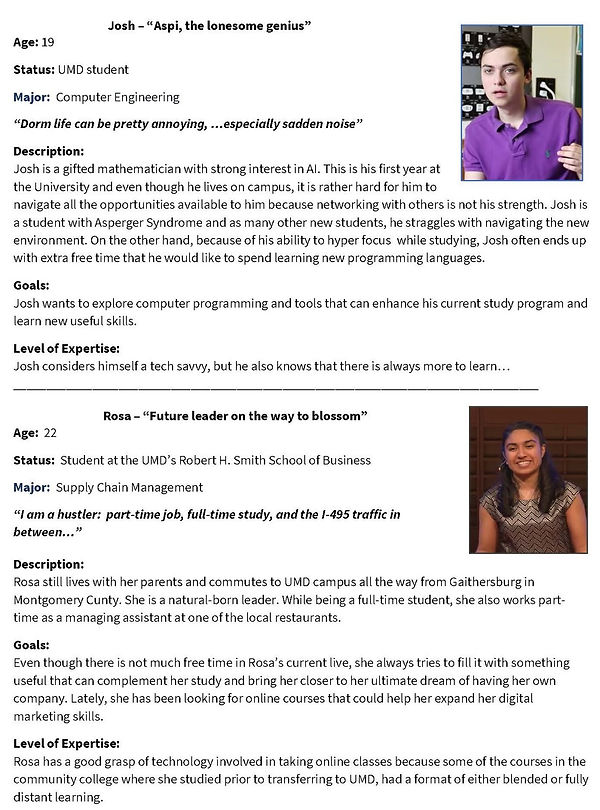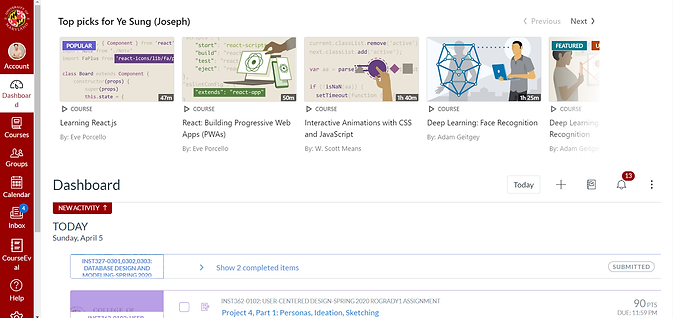Personas, Ideation, Sketching
Our inquiry and subsequent analysis of UMD students’ low participation in LinkedIn Learning has continually been reshaping our mental model of processes involved in influencing the level of students’ engagement in those services. Based on the convincing contextual evidence we were able to connect the root of this problem with more broad, general lack of access to centralized information about all the benefits that being a UMD student offers, including free access to LinkedIn Learning courses. What we came to realize is that many opportunities available to students rely on side channels of information, including word of mouth, or the information about them is divulged within particular student organizations or departments (e.g. Career Center) and is usually known by those who are somehow engaged in their activities. This model for flowing of information can in some way be looked at as desirable by the nature of UMD as an educational organization where the underlying intention is to teach students to advocate for themselves and develop their information seeking abilities through active engagement with the community. However, this approach can also create a level of restriction and disadvantage in harnessing all the opportunities that UMD students are entitled to, particularly for those having less access to information circulating via word of mouth (e.g. commuting students with significant time constraints or students who are just less inclined to social interactions). Furthermore, the events of the past few weeks and the related move to online learning have proven and emphasized even more the need for a well-organized and easily accessible online information system that can support student engagement in everything that University’s organizational structure has to offer to them; that includes the available opportunity for free access to LinkedIn Learning. Our initial position was that a multilayered student-centered information campaign by various departments and staff members (e.g. Career Center, faculty and student advisory staff) could collectively improve students' awareness about the LinkedIn Learning courses. It still holds true, but it is also clear that this information should be part of or somehow linked to a centralized online information system that every student is familiar with and uses frequently (e.g. Elms, Testudo).
Our current goal is to analyze the relationship between UMD’s online platforms that students use most often on one side, and students’ motivation underlying their information seeking behavior on the other side. This endeavor is an attempt to establish a mental model in regard to how students obtain knowledge about available opportunities for extracurricular learning. This analysis is to be conducted in the ecological perspective where the main task is to identify the platform that would be the most fitting with the identified mental model and thus most appropriate to have the information on LinkedIn as part of its content. This approach should eventually lead us towards the best design solution. We start from developing personas that can provide well rounded representation of the identified users.
Personas
In this stage of the design process we dig deeper into motivations guiding our target user, UMD student, in regards to their information seeking behaviors related to obtaining knowledge about available opportunities and acquiring an awareness of benefits that LinkedIn Learning has to offer. The goal of this endeavor is to establish a mental model in the ecological perspective that is as accurate as possible and eventually can lead us towards the best design solution. We start from developing three personas which provide well rounded representation of the identified users.




Ideation Sketches
In this stage of the design process we dig deeper into motivations guiding our target user, UMD student, in regards to their information seeking behaviors related to obtaining knowledge about available opportunities and acquiring an awareness of benefits that LinkedIn Learning has to offer. The goal of this endeavor is to establish a mental model in the ecological perspective that is as accurate as possible and eventually can lead us towards the best design solution. We start from developing three personas which provide well rounded representation of the identified users.

This sketch provides a visualisation of the adjustment of the main page of the Elms (Canvas) page. The scrollable section includes various course suggestion lists generated from linkedIn Learning. Clicking any of the courses will take you to LinkedIn Learning website and students will be able to proceed with the course right away.

This sketch provides a visualisation of the adjustment to the main tabs on each student’s career center page. The LinkedIn tab would add an option to LinkedIn and LinkedIn Learning. Furthermore, LinkedIn Learning tab can navigate directly to several courses that students want to take. There is also a LinkedIn Learning button in the bottom of the page to take students directly to the page.

This sketch provides a visualisation of the adjustment to the main tabs on each student’s Testudo page. The tab for the link will link it to the Linkedin page, where students who have an account can login in. For students who don’t have an account can see a link at the bottom to Join for new people where they can sign up with their college information.

This sketch provides a visualisation of the adjustment to the main tabs on each student’s Elms (Canvas) page; the tab for links would add the page with helpful links that would include the link for free LinkedIn Learning services and free software for UMD students:
https://linkedinlearning.umd.edu/
and
